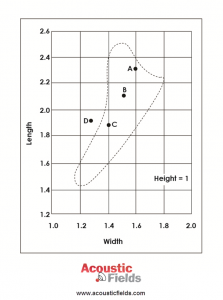I recently made reference to the Bonello graph in one of my weekly videos and one of our YouTube subscribers asked me how he would apply it to his room which is twelve by sixteen by eight. Okay so just for everyone’s general knowledge, whenever you see even dimensions in a room twelve, sixteen, eight, etc, all divisible by two then that’s not good, not good at all.
We have to have irregular distances not ratios of matched distances. Anything that’s divisible by two, eight, six, twelve, fourteen, you don’t want those connected. You would want an eight with a seven, i.e. one even and an odd but that’s a subject for another issue.
Now to the Bonello graph. Bonello was an engineer that came up with a series of height, width and length ratios and plotted a graph and then gave you a little reference point that you could take your room size keeping one of the dimensions at one constant and then figuring out what good ratios you have to work with and try to fall within. Its an amoeba like outline on a graph as shown below.
How did he do that? He took room sizes, many room sizes and he analyzed the pressure and the modal pressure in the room. Then he took all the pressure patterns and he found the best ratios where the pressure patterns were separated by ten dB or more because he thought ten dB or more separation, and modal pressure issues reduce the pressure, well I’m not going to say inaudible but made it more easy to manage and that’s a good criteria we use today.
I don’t use ten dB, I spread it out a little farther to twelve, thirteen, fourteen because I think it’s a little bit better. Unfortunately sometimes we don’t have the space to do that. So that was the basis for Bonello’s analysis and graph that you see. Septa Meyer is another one that came up with another way of doing it. He still kept all those premises in mind but skewed the ratios a little bit and I can’t honestly remember why but I know that’s the difference and then there’s a few more.
Room Usage Is Always Critical
There is no set number that I can give you because there are so many variables and usage is so critical. If it’s a live room we can get away with certain things that we can’t in a control room. If it’s a control room we can get away with certain things that we can’t in a listening room so it all depends on usage.
What you’re trying to do and what ratios you should use depends on that usage. There are a lot of variables, how much pressure is going to be in the room as a result of the usage? The pressure levels in control rooms are probably the same as pressure levels in live rooms especially with drums. The pressure levels of vocal rooms are not even close to the pressure levels in a control or a live room.
So it’s really important to look at the usage, find out what you’re going to do, find out the maximum footprint that you have to work with and then kind of use that as your boundary not to exceed and then backpedal a little bit and fill in with usage. I hope that makes a little sense.
In Summary
If you would like to learn more about room acoustics please sign up for my free videos and ebook here. And if you would like your room acoustic issues analysed for free by me then please fill in the form here and I will be happy to take a look for you.
Thanks
Dennis









Dear Mr Foley:
Sorry to say you that you are not speaking about the “Bonello Criteria” (published in AES Journal, 1981) The graph that you comment IS NOT my work. You refer to the old Richard BOLT graph (July- 1946) that nobody uses during the last 30 years.
The Bonello Criteria is based on solid Psychoacoustics concepts and not in math properties. Please read the original work or you can read it at the “Handbook for Sound Engineers” Glen Ballou, editor.
Oscar Bonello, University of Buenos Aires
Oscar, Thank you for pointing this error out. I would like to do a video on Bolt vs. Bonello. Would you assist me?